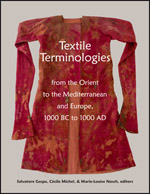Center, Textile Research

Textile Terminologies from the Orient to the Mediterranean and Europe, 1000 BC to 1000 AD
Date of this Version
2017
Document Type
Article
Citation
In Textile Terminologies from the Orient to the Mediterranean and Europe, 1000 BC to 1000 AD, ed. Salvatore Gaspa, Cécile Michel, & Marie-Louise Nosch (Lincoln, NE: Zea Books, 2017), pp. 256-277.
doi:10.13014/K2K35RT4
Abstract
The Edictum Diocletiani et collegarum: The so-called Edict of Maximum Prices was issued in AD 301 as part of a comprehensive administrative and financial reform released in the reign of the Roman emperor Diocletian. Diocletian came to power in AD 284 after a period in Roman history traditionally understood as a time of ‘crisis’, produced by a series of inter-related factors: a frequent turnover of emperors; problems with the economy in terms of production and coinage; incursions by various tribes on the edges of the empire; internal unrest; the rise of Christianity and periodic persecutions. Diocletian’s actions were arguably pragmatic responses to the situation he found the empire in on his accession. The Edict should be seen alongside a number of reforms during his reign and is regarded by some scholars as the most important inscription of Late Antiquity. Several editions and translations have been published thus far. In addition to the continuous publication of new finds of the text itself, commentaries on different aspects of the Edict abound.
The main purpose of the Edict, at least according to its own preface, was to fix maximum prices for a wide range of services and products that had constantly been jeopardized by the avarice of some merchants and traders who were known to ask for prices up to 8 times the usual amount. According to the text itself, the main beneficiaries of the Edict were the soldiers of the Roman army with a fixed salary that would not have allowed them to purchase the above-mentioned products and services at such excessive prices. The prices mentioned regard transportation, food, wages for craftsmen as well as special goods such as marble and numerous clothing items and textiles. All in all, around 1300 items, wages, and services are mentioned. In detail, studies on specific materials mentioned in the Edict, like glass and marble, are well covered as are those on the different areas of production, services, and costs for transport. Some aspects of ancient textile technology and clothing have been treated in greater detail, such as the different types of purple mentioned, wool, clothing and cloth, as well as specific terminological questions related to clothes. Despite this interest in the range and types of clothing, scholarship has not yet focussed on the textile tools mentioned in the Edict. This contribution proposes to fill part of this gap.
Included in
Ancient History, Greek and Roman through Late Antiquity Commons, Art and Materials Conservation Commons, Classical Archaeology and Art History Commons, Classical Literature and Philology Commons, Fiber, Textile, and Weaving Arts Commons, Indo-European Linguistics and Philology Commons, Jewish Studies Commons, Museum Studies Commons, Near Eastern Languages and Societies Commons, Other History of Art, Architecture, and Archaeology Commons


Comments
Copyright © 2017 Salvatore Gaspa, Cécile Michel, & Marie-Louise Nosch. Photographs copyright as noted.